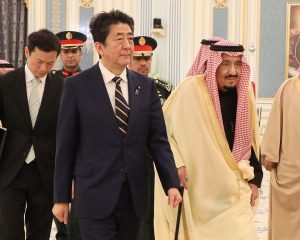Japanese Prime Minister Shinzo Abe is on a five-day trip to the Middle East hoping to bring a “unique” brand of “peace diplomacy” amid escalating threats of retaliation between the United States and Iran.
Last week, local media cited government officials who predicted Abe would cancel his diplomatic tour in the wake of the U.S assassination of Iranian Quds Force Commander General Qassem Soleimani. But Abe stuck to his original schedule. Before flying to Saudi Arabia, followed by the United Arab Emirates and Oman, Abe told reporters at Haneda airport he hoped to ease flaring tensions by “promoting dialogue, self-restraint and persistent peaceful diplomacy.”
Resource-poor Japan relies on the Middle East for 90 percent of its oil supply and there are concerns rising tensions could jeopardize Japan’s energy security. In June last year a Japanese commercial ship carrying 25,000 tons of methanol was attacked by a drone in the Gulf of Oman, even as Abe was in Tehran.
Before Iran-U.S. tensions were pushed to the brink of war, Abe’s cabinet approved the dispatch of a Maritime Self Defense Force (MSDF) contingent to the region in December as a part of an intel-gathering mission seeking to secure safe sea lanes for Japanese vessels. The Abe government decided not to join the U.S.-led voluntary coalition to protect Middle Eastern waterways, opting for an “independent” naval mission that avoids the Strait of Hormuz in an effort to retain friendly ties with Iran and prevent damage to their politically neutral position in the region. The MSDF fleet, made up of two patrol planes and a naval destroyer, is expected to depart after February 2 and will concentrate operations in the Gulf of Oman and the northern Arabian Sea.
Abe touched down in the Saudi Arabian capital of Riyadh late on January 11 and met with King Salman and Crown Prince Mohammad the next day, seeking the fellow U.S. ally’s understanding and cooperation to ensure that preparations for the MSDF dispatch go ahead smoothly.
Saudi Arabia broke off diplomatic relations with Iran following an attack on the Saudi Arabian embassy in Tehran four years ago. In contrast to Japan’s friendly relations with Iran, relations between the two neighbors remain sour. Abe’s visit to Saudi Arabia serves in part as a mediation tour to prevent the U.S.-Iran conflict from spreading to neighboring countries. Abe said he wanted to urge leaders to pursue diplomacy and encouraged Saudi Arabia to start dialogue with Iran to help calm down and stabilize the situation.
With the risk of war on the horizon, a growing concern for Saudi Arabia is the impact on its banking and tourism industry, which is heavily supported by the revenue brought in from oil.
Saudi Arabian Foreign Minister Faisal bin Farhan told Asahi Shimbun “we share the same view of wanting to avoid armed conflict as much as possible.”’ Farhan added that Saudi Arabia is looking to Japan to leverage its ties with Iran and serve as an intermediary, saying he hoped “Japan could contribute by delivering the international community’s message to Iran.”
Meanwhile, in the UAE, both the capital of Abu Dhabi and commercial capital of Dubai have a population that is 90 percent foreigners. The country is hoping to improve relations with Iran. Abe is also looking to secure confirmation from Oman to enable the MSDF to use the country’s ports and facilities.
In the time between the cabinet approving the MSDF mission in December and the diet reconvening on January 20, the deteriorating security situation in the Middle East brings into play new facts and risks. Following Iran’s attack on U.S. troops in Iraq and threats of an “attack” on neighboring countries housing U.S. troops, there are calls for the cabinet to reconsider how to respond to the situation in the Middle East, starting with postponing MSDF deployment. There are also concerns the government has failed to sufficiently explain to the public why MSDF troops must be deployed in light of the volatile situation.

































